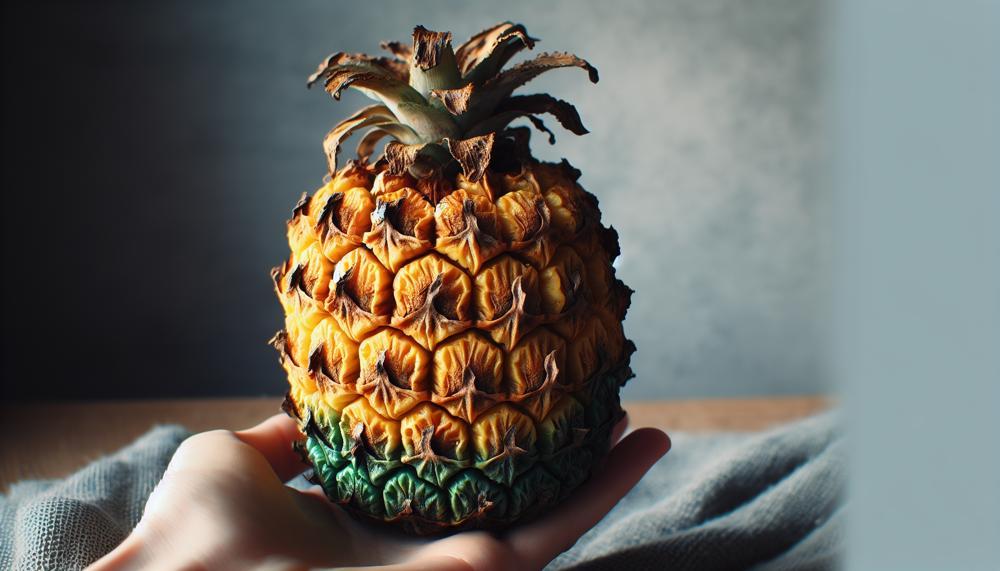Are you a lover of all things tropical and tangy? Do you find yourself constantly reaching for the vibrant and juicy pineapple to add to your favorite dishes? We don’t blame you. But what happens when you cut into that perfect-looking pineapple, only to discover it has gone bad?
In this blog post, we’ll be sharing some tips on how to determine if your pineapple is still good to eat after being cut.
Before you toss that questionable fruit into the trash, let’s go over a few things:
- The smell test: Take a whiff of your pineapple. Does it have a sweet and fruity aroma or does it smell sour or fermented? Trust your nose; it’s usually the first indicator of spoilage.
- Visual cues: Check the color of the flesh. Is it vibrant yellow or has it turned brownish? Also, keep an eye out for any mold or discoloration on the skin.
- Texture matters: Give your pineapple a gentle squeeze. A fresh one should feel firm but slightly soft. If it’s mushy or overly soft, that’s a clear sign of spoilage.
- Taste test: When all else fails, take a small bite. If it tastes off or unpleasant, then unfortunately, your pineapple has gone bad.
Now that you know what to look out for, let’s dive deeper into determining if your beloved pineapple is still safe to eat after being cut.
Contents
How Do You Know When Pineapple Is Bad?
To quickly determine if a cut pineapple has gone bad, you can look for these signs:
| Indicators of spoilage | What to search for |
| Brown or discolored color | The pineapple may have turned brown or darker in color, indicating that it is no longer fresh. |
| Sour or off smell | If the pineapple smells sour or has a strange odor, it may be a sign of spoilage. |
| Slimy or sticky texture | Pineapple that has gone bad may feel slimy or sticky to the touch. |
| Visible mold | Check for visible mold on the pineapple. If you see any, it is best to discard the fruit. |
| Dried or discolored top leaves | The top leaves of the pineapple may become dry or discolored if it has gone bad. |
| Soft spots or lots of bruises | If the pineapple has soft spots or bruises, it may be a sign that it is starting to go bad. |
| Moldy, wet, or mushy bottom | The bottom of the pineapple may develop mold or become wet and mushy if it is no longer fresh. |
| Paler yellow or whitish color | A fresh pineapple should have a bright yellow color. If it appears paler or whitish, it may have gone bad. |
| Drying out | Pineapple that has gone bad may start to dry out and lose its juiciness. |
If you notice any of these signs, it is best to dispose of the pineapple to avoid any potential health risks. Consuming spoiled pineapple can lead to foodborne illnesses and should be avoided.
To prevent pineapples from going bad quickly, make sure to store them properly in the refrigerator and consume them within a few days after cutting.
Lastly, always trust your senses when it comes to determining if a cut pineapple is bad. If it doesn’t look, smell, or taste fresh, it’s better to be safe than sorry and throw it away.
How To Tell If Your Pineapple Is Bad: Texture
When examining a sliced pineapple, its texture can provide crucial hints about its freshness and safety.
Here are the main points to keep in mind when checking for spoilage:
Softness and drooping leaves
A new and healthy pineapple should have a firm and crispy texture. If the pineapple feels mushy or soft, it is a sign that it has turned bad.
Furthermore, wilted or sagging leaves on top of the pineapple indicate that it is no longer at its best.
Strong or sour smell
A powerful or sour scent is another indicator of spoilage in a pineapple.
If it has a strong or unpleasant smell, it is best to discard it.
Changes in color
Pay attention to any alterations in color on the pineapple.
Dark yellow, orange, brown, or white patches on the base of the fruit are signs of spoilage.
Mold growth
Fuzzy white spots or black areas on a pineapple are indications that it has developed mold and should not be consumed.
Bitter taste
A bitter taste is another indication that the pineapple has gone bad. If it tastes unpleasant or off, it is best to avoid eating it.
To summarize, when examining the texture of a cut pineapple, take note of sogginess, wilted leaves, changes in color, mold growth, and a bitter taste as signs of spoilage. It is important to dispose of any pineapples that exhibit these qualities to avoid consuming spoiled food.
To prevent this from occurring, select a fresh and vibrant pineapple at the store and store it properly depending on when it will be consumed.
How To Tell If Your Pineapple Is Bad: Smell
To determine if a pineapple is no longer suitable for consumption, you can rely on your sense of smell for guidance.
A ripe and juicy pineapple should exude a pleasant, tropical scent. However, if the pineapple has gone bad, its aroma will change and become sour or unpleasant.
This is caused by the breakdown of enzymes and fermentation of sugars, resulting in a foul odor.
To accurately assess the smell of a pineapple, follow these steps:
- Before slicing into it, smell the entire pineapple. If it emits a sour or off-putting scent, it is most likely spoiled and should be discarded.
- If the whole pineapple smells fine, cut it open and take a whiff. The flesh should have a slightly sweet and acidic aroma. If it gives off a funky or rancid scent, it is probably bad.
- In addition to checking the smell, keep an eye out for any signs of mold or black spots on the flesh. These are clear indicators that the pineapple has gone bad.
- If you notice any of these signs, it is best to err on the side of caution and dispose of the pineapple. Consuming spoiled food can lead to food poisoning and other health concerns. It is always better to be safe than sorry when it comes to food safety.
Table:
| Indications of a Spoiled Pineapple | Unpleasant Smell | Reason Behind It |
| Brown or Discolored Exterior | Sour or Off-Putting Odor | The breakdown of enzymes and fermentation of sugars cause an unpleasant smell. |
| Slimy or Sticky Texture | Sour or Off-Putting Odor | The sliminess and stickiness are caused by bacteria growth which also produces a foul smell. |
| Soft and Mushy Texture | Sour or Off-Putting Odor | Similar to the slimy and sticky texture, the soft and mushy texture is a result of bacteria growth and the breakdown of the fruit’s structure. |
| Black Spots or Mold Growth | Sour or Off-Putting Odor | Mold and bacteria produce a musty or foul smell. |
| Brown, Mushy Flesh when Cut Open | Sour or Off-Putting Odor | The brown and mushy flesh indicates that the pineapple is overripe and has started to rot. |
Remember that a ripe and juicy pineapple should give off a sweet, tropical scent.
If you notice any changes in smell, texture, or appearance, it is best to dispose of the pineapple to avoid any potential health risks.
How To Tell If Your Pineapple Is Bad: Color
When it comes to determining if a cut pineapple has gone bad, changes in color can be a helpful indicator. Here are the color changes to pay attention to when checking for spoilage in a cut pineapple:
| Color Changes | Indication of Spoiled Pineapple |
| Brown or discolored | Sign of oxidation and potential bacterial growth |
| Black spots or mold | Sign of mold growth and potential contamination |
| Brown, mushy flesh when cut open | Sign of overripe or spoiled pineapple |
These color changes can occur due to exposure to air and bacteria, resulting in spoilage and potential foodborne illness. If your cut pineapple displays any of these color changes, it is best to dispose of it to avoid any potential health risks.
In addition to color changes, other indications of a bad pineapple include a sour or unpleasant smell, slimy or sticky texture, and soft and mushy texture. Properly storing and handling pineapples is crucial for prolonging their freshness and preventing spoilage.
Overall, being mindful of color changes in a cut pineapple can help determine if it has gone bad. If the fruit shows signs of browning, black spots, or brown mushy flesh, it is best to discard it to avoid any potential foodborne illness.
How To Tell If Your Pineapple Is Bad: Mold
Mold is a common occurrence on cut pineapples due to their high moisture content and short shelf life. To ensure food safety and prevent food waste, it’s crucial to properly identify and handle moldy pineapples.
Keep these tips in mind when inspecting your cut pineapple for mold:
Look for white spots
If you see white spots on the leaves or exterior of your pineapple, it’s likely mold and the fruit should be discarded.
Fuzzy white spots on the inside or outside of the pineapple are also a telltale sign of mold.
Check for polyps
Sometimes, mold can manifest as small, white polyps on the flesh of the pineapple.
These may be found along indentations on the fruit’s surface.
Smell the pineapple
A bad smell emanating from your pineapple may indicate mold or bacterial growth.
Examine for spots
Brown or black spots on the flesh of your cut pineapple may also be indicative of mold growth.
Press the pineapple
If your pineapple feels too soft when you press it, it may be bad and should be discarded.
If you come across any signs of mold on your cut pineapple, it’s best to throw it away to avoid consuming potentially harmful bacteria or toxins.
To prevent mold in the future, properly store your pineapples in an airtight container or wrap them in plastic wrap before refrigeration.
Additionally, squirting some lemon or lime juice on the cut pieces can prevent browning and prolong their freshness.
How To Tell If Your Pineapple Is Bad: Taste
One of the simplest ways to judge is by taking a taste. Here are some important points to keep in mind:

- First and foremost, trust your senses. Any changes in color, smell, or texture could be a sign that your pineapple is beginning to spoil.
- A new and ripe pineapple should have a sweet and slightly tangy flavor. If your pineapple tastes overly bitter or has an unusual taste, it may have started to go bad.
- When tasting, pay attention to the texture as well. A fresh pineapple should be firm and juicy. If it feels soggy or dry, it may have gone bad.
- Additionally, check for any visible signs of mold on the pineapple. Mold can be harmful if consumed and is a clear indication that the fruit has spoiled.
- If you still have doubts about the freshness of your pineapple, cut it open. Brown or mushy flesh inside is a sure sign that the fruit has gone bad and should be discarded.
Conclusion
In conclusion, determining if your cut pineapple has gone bad is all about using your senses.
The smell test, visual cues, texture, and taste are all key indicators of freshness. Keep an eye out for changes in color, a pungent or unpleasant smell, slimy or mushy texture, and a less-than-ideal taste.
These are all red flags that your beloved pineapple may have spoiled and should be tossed to avoid any potential health risks.
Proper storage and handling techniques can also help extend the shelf life of pineapples and prevent spoilage.




